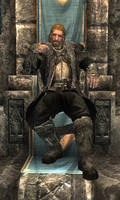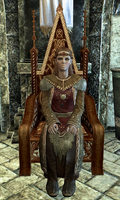No edit summary Tags: Visual edit apiedit |
No edit summary |
||
| (43 intermediate revisions by 20 users not shown) | |||
| Line 1: | Line 1: | ||
| − | {{ |
+ | {{Split}} |
| ⚫ | |||
| ⚫ | |||
| + | The '''High King''' or '''High Queen''' is a monarch who is typically responsible for governing the [[province]], although in places with High Kings or Queens, the holds, regions, or provinces usually have more autonomy than in other places.{{fact}} |
||
| ⚫ | |||
| − | The '''High King''' or '''High Queen''' is the leader of [[Skyrim]]. Governing the [[province]], those holding this office become a member of the [[Elder Council]] of the [[Empire of Tamriel]]. Originally, the High King was based in [[Windhelm]], as it was the first capital city established by [[Ysgramor (Lore)|Ysgramor]] in the late [[Merethic Era]]. The Capital had also shifted to [[Winterhold]] sometime in the [[First Era]], but as of the [[Fourth Era]], the High King reigns from [[Solitude (Skyrim)|Solitude]]. |
||
| − | == |
+ | ==Skyrim== |
| ⚫ | |||
| − | + | In Skyrim, the High King or Queen typically inherits the throne by birth and rules for life or until abdication.{{Cite}} In the event that no direct heir to the throne exists, High Kings are selected by a [[moot]], or vote, conducted by the current [[Jarl]]s of each of the nine [[Holds]].<ref name="rule">''[[Skyrim's Rule]]''</ref> High Kings are traditionally either related to the previous High King,<ref name="PGE1:S">''[[Pocket Guide to the Empire, First Edition: Skyrim]]''</ref> or a Jarl of one of the Holds.<ref name="rule"/> Votes occur most commonly when the previous High King dies. By Nordic tradition, a High King can be challenged in a duel of arms for the right to the throne. If they refuse, the challenger has grounds to call for a moot to elect a new High King.<ref name="Sybille">Dialogue with [[Sybille Stentor]]</ref><ref name="UlfricDialogue"/> |
|
| − | The High King swears fealty to the [[Emperor]], and as such [[Solitude]] is the city most directly influenced by Imperial culture and politics |
+ | The High King swears fealty to the [[Emperor]], and as such [[Solitude]] is the city most directly influenced by Imperial culture and politics; thus the Jarl of Solitude has served as High King for generations. According to some source the Moot is, therefore, more formality and theater than anything else.<ref name="rule" /> Other sources state that the Moot always meets to select a new High King.<ref name="LsS">[[Loading Screens (Skyrim)]]</ref> Originally, the High King was based in [[Windhelm]], as it was the first capital city established by [[Ysgramor]] in the late [[Merethic Era]]. The Capital had also shifted to [[Winterhold]] sometime in the [[First Era]], but as of the [[Fourth Era]], the High King reigns from [[Solitude (Skyrim)|Solitude]]. |
| + | ===History=== |
||
| ⚫ | |||
| + | ====Second Era==== |
||
| + | As a result of the [[Reman Empire]]'s fall in [[2E 431]], High King [[Logrolf]] was assassinated. When Jarl [[Svartr]] claimed his daughter [[Freydis]] was illegitimate, a partial moot in Windhelm convened Freydis was High Queen, while a partial moot in Solitude convened Svartr was High king. As a result, the province was split into the West and East kingdoms, ruled separately by each High Kings of the capitals.<ref name="Freydis">''[[The Crown of Freydis]]''</ref> In [[2E 582]], High King [[Svargrim]] ruled the West Kingdom while High King [[Jorunn the Skald-King]] ruled the East Kingdom.<ref name="Online">Events of {{Online}}</ref> |
||
| − | === |
+ | ====Fourth Era==== |
| ⚫ | |||
| − | In the [[Fourth Era]], upon the death of High King [[Torygg]], the Jarls could not agree on the next High King. Torygg's widow, [[Elisif the Fair]], Jarl of Solitude, had a legitimate claim to the throne<ref name=" |
+ | In the [[Fourth Era]], upon the death of High King [[Torygg]], the Jarls could not agree on the next High King. Torygg's widow, [[Elisif the Fair]], the Jarl of Solitude, had a legitimate claim to the throne.<ref name="UlfricDialogue">Dialogue with [[Ulfric Stormcloak (Skyrim)|Ulfric Stormcloak]]</ref> However, according to [[Ulfric Stormcloak]], the Jarl of [[Windhelm (Skyrim)|Windhelm]], ancient Nord tradition dictates that when the High King is bested in battle, the winner can call a Moot to have a new High King chosen.<ref name="UlfricDialogue"/> Ulfric believed this gave him a stronger claim to the throne.<ref name="UlfricDialogue"/> This resulted in [[Skyrim Civil War|Civil War]] because the Empire considered the duel unfair and an act of murder, due to Ulfric's use of the [[Thu'um]].<ref name="Sybille" /> It is strongly implied that Ulfric initiated the challenge, plotting to intimidate the other Jarls into naming him High King,<ref name="Elisif">Dialogue with [[Elisif the Fair]]</ref><ref name="UlfricDialogue"/> though Ulfric and his supporters maintained it was a lawful challenge to prove Torygg's weakness as a leader and Skyrim's wretched condition.<ref name="UlfricDialogue"/><ref>Dialogue with [[Gerdur]]</ref> However, if the city of [[Battle for Solitude|Solitude is taken]] by the [[Stormcloaks]] and the war resolved in their favor, Ulfric's earlier statement is proven true; saying he supports the decision of the Moot, whether he is crowned King or not. However, he still asks Elisif to swear fealty to him,<ref name="UlfricDialogue"/> and all Jarls who fought against him are replaced.<ref>Conclusions of hold battles in the [[Skyrim Civil War]]</ref> |
| − | ==Previous rulers== |
+ | ===Previous rulers=== |
| − | Listed below are the previous High Kings and Queens of [[Skyrim]] followed by their respective reigns: |
+ | Listed below are the previous High Kings and High Queens of [[Skyrim]] followed by their respective reigns: |
| − | *[[Harald]] |
+ | *High King [[Harald]] of [[Windhelm]], Founder of the [[Skyrim|Kingdom of Skyrim]] ([[1E 143]] – [[1E 221]])<ref name="palace">Plaque outside of the [[Palace of the Kings]]</ref><ref>''[[Frontier, Conquest]]''</ref> |
| − | *[[Hjalmer]] |
+ | *High King [[Hjalmer]] of Windhelm – (1E 221 – 1E 222) |
| − | *[[Vrage]] |
+ | *High King [[Vrage]] of Windhelm – (1E 222 – 1E 2?)<ref name="PGE1:S"/><ref>''[[King Edward, Book X]]''</ref> |
| − | *[[Gellir]] |
+ | *High King [[Gellir]] – (1E 2? – 1E ?)<ref>''[[The Aetherium Wars]]''</ref> |
| − | *[[Borgas]] |
+ | *High King [[Borgas]] of [[Winterhold]], last of the [[Ysgramor Dynasty]] (1E ? – [[1E 369]])<ref>''[[A History of Daggerfall]]''</ref> |
| − | *[[Olaf One-Eye]] |
+ | *High King [[Olaf One-Eye]] of [[Whiterun]] (1E 420 – 1E 452)<ref name="palace" /> |
| − | *[[Kjoric the White]] |
+ | *High King [[Kjoric the White]] (1E 4? – 1E 478)<ref name="RR">''[[Rislav the Righteous]]''</ref> |
| − | *[[Hoag Merkiller]] |
+ | *High King [[Hoag Merkiller]] (1E 478 – 1E 480)<ref name="RR" /><ref>''[[The Five Songs of Wulfharth]]''</ref> |
| − | *[[Wulfharth]] |
+ | *High King [[Wulfharth]] (1E 480 – 1E 533)<ref name="palace" /> |
| − | *[[Logrolf]] |
+ | *High King [[Logrolf the Willful|Logrolf]] of Windhelm (2E ? – 2E 431)<ref name="Freydis">''[[The Crown of Freydis]]''</ref> |
| ⚫ | |||
| − | *[[Jorunn the Skald-King]] - (2E 583 - 2E ?)<ref>Events of {{Online}}</ref> |
||
| ⚫ | |||
| ⚫ | |||
| ⚫ | |||
| ⚫ | |||
| + | *High King [[Svargrim]] of Solitude - disputed only controlled Western Skyrim (2E 561 – 2E ?) |
||
| ⚫ | |||
| + | *High King [[Jorunn the Skald-King]] of Windhelm and the [[Ebonheart Pact]] - disputed only controlled Eastern Skyrim – (2E 582 – 2E ?)<ref name="Online" /> |
||
| ⚫ | |||
| ⚫ | |||
| ⚫ | |||
| − | === |
+ | ====The Jagged Crown==== |
| − | Not all kings and queens within the province of [[Skyrim]] attain the mantle of High King. While many people outside of Skyrim consider [[Jarl]]s of the [[Fourth Era]] to be pseudo-kings and queens, they are often not royalty. It should be noted that it is possible that Imperial scholars with no real understanding of Nordic society incorrectly labelled these individuals as monarchs when they were in fact Jarls. |
||
| − | |||
| − | The following are individuals who have been recorded as monarchs of individual city states throughout the history of Skyrim: |
||
| ⚫ | |||
| ⚫ | |||
| ⚫ | |||
| − | *Jorunn the Skald-King, King of Eastern Skyrim - (2E 583 - 2E ?)<ref>Events of {{Online}}</ref> Became High King after a Moot. |
||
| − | *[[Cuhlecain]], King of [[Falkreath]] - late [[Second Era]] (note: Falkreath was considered to be part of [[Colovia]] at this time) |
||
| − | *King [[Mantiarco]] of [[Solitude]] (3E ? - 3E 99)<ref name="TWQII">''[[The Wolf Queen, Book II]]''</ref> |
||
| − | *[[Amodetha]], Queen of Solitude - Late [[Third Era]]<ref name="TWQII"/> |
||
| − | *[[Potema Septim|Potema]], Wolf Queen of Solitude - ([[3E 81]] - [[3E 137]]) |
||
| − | *[[Pelagius Septim III]], King of Solitude - ([[3E 137]] - [[3E 145]])<ref>''[[The Wolf Queen, Book VIII]]''</ref><ref name="tmop">''[[The Madness of Pelagius]]''</ref> |
||
| − | *[[Jolethe Direnni]], Queen of Solitude - ([[3E 145]] - 3E ?)<ref name="tmop">[[The Madness of Pelagius]]</ref> |
||
| ⚫ | |||
| − | *Queen [[Macalla]] of [[Dawnstar]] - late Third Era<ref name="PGE3:S">[[Pocket Guide to the Empire, Third Edition: Skyrim]]</ref> |
||
| − | |||
| − | ==The Jagged Crown== |
||
[[File:Bonecrowngo.png|thumb|180px|[[The Jagged Crown (Item)|The Jagged Crown]], the Crown Jewel of the High King of Skyrim.]] |
[[File:Bonecrowngo.png|thumb|180px|[[The Jagged Crown (Item)|The Jagged Crown]], the Crown Jewel of the High King of Skyrim.]] |
||
{{Main|The Jagged Crown (Item){{!}}The Jagged Crown}} |
{{Main|The Jagged Crown (Item){{!}}The Jagged Crown}} |
||
[[The Jagged Crown (Item)|The Jagged Crown]] is the crown of the High King of [[Skyrim]] and was used to symbolizes the power over Skyrim. It is made from the teeth and bones of [[Dragons (Lore)|dragons]]. It is believed to date back to the time of [[Harald|King Harald]] and is said to contain a portion of the power of every king or queen who wore it since.<ref name="galmar">Dialogue with [[Galmar Stone-Fist]]</ref> |
[[The Jagged Crown (Item)|The Jagged Crown]] is the crown of the High King of [[Skyrim]] and was used to symbolizes the power over Skyrim. It is made from the teeth and bones of [[Dragons (Lore)|dragons]]. It is believed to date back to the time of [[Harald|King Harald]] and is said to contain a portion of the power of every king or queen who wore it since.<ref name="galmar">Dialogue with [[Galmar Stone-Fist]]</ref> |
||
| − | The last monarch to wear the crown was King [[Borgas]], but it was believed lost when he was killed in the [[Wild Hunt]] of [[1E 369]]. Legend holds that his body was secretly returned to Skyrim and buried with the crown, but the exact whereabouts were lost in the following [[War of Succession]].<ref name="galmar"/> During the Civil War questline, the Dragonborn can help recover the crown for either the [[Imperial Legion (Skyrim)|Imperial Legion]] or the [[Stormcloaks]], providing a great symbolic victory to the side in question. |
+ | The last monarch to wear the crown was King [[Borgas]], but it was believed lost when he was killed in the [[Wild Hunt]] of [[1E 369]]. Legend holds that his body was secretly returned to Skyrim and buried with the crown, but the exact whereabouts were lost in the following [[War of Succession]].<ref name="galmar" /> During the Civil War questline, the Dragonborn can help recover the crown for either the [[Imperial Legion (Skyrim)|Imperial Legion]] or the [[Stormcloaks]], providing a great symbolic victory to the side in question. |
| − | ==The Crown of Verity== |
+ | ====The Crown of Verity==== |
{{Main|Crown of Verity}} |
{{Main|Crown of Verity}} |
||
The Crown of Verity was an alternative to the Jagged Crown created when the Jagged Crown was lost in the Wild Hunt of 1E 369. It infamously rejected [[Asurn Ice-Breaker]] as High King in the fifth century of the First Era, cementing its authority deep into Skyrim's politics.<ref name="Freydis"/> |
The Crown of Verity was an alternative to the Jagged Crown created when the Jagged Crown was lost in the Wild Hunt of 1E 369. It infamously rejected [[Asurn Ice-Breaker]] as High King in the fifth century of the First Era, cementing its authority deep into Skyrim's politics.<ref name="Freydis"/> |
||
| + | |||
| + | ==High Rock== |
||
| + | [[File:High King Emeric card art.png|thumb|263x263px|High King Emeric]] |
||
| + | {{Main|Emeric of Cumberland}} |
||
| + | In [[High Rock]] there has only ever been one High King, [[Emeric of Cumberland]]. A master warrior, brilliant politician, well-rounded in trading, speechcraft, and a brilliant strategist, he was also the King of [[Wayrest]], High King of High Rock, the founder and Leader of the [[Daggerfall Covenant]], and the founder of the [[Cumberland Dynasty]]. |
||
| + | |||
| + | ==Hammerfell== |
||
| ⚫ | |||
| + | **Prince [[A'Tor]], Thassad II Son and heir, mortally wounded during the [[Battle of Hunding Bay]].<ref>Intro of {{Redguard}}</ref> |
||
==Other nobility== |
==Other nobility== |
||
| Line 69: | Line 68: | ||
*In ancient and Early Medieval Ireland, the high king (''Ard Ri'') was a symbolic ruler who professed to have lordship over the whole of Ireland. However, most high king's actual power rarely extended past their native tuatha (tribal kingdom). |
*In ancient and Early Medieval Ireland, the high king (''Ard Ri'') was a symbolic ruler who professed to have lordship over the whole of Ireland. However, most high king's actual power rarely extended past their native tuatha (tribal kingdom). |
||
*Similarly, in ancient and medieval Germanic Europe (on which Skyrim and the Nords are largely based), authority was usually bestowed upon a high king or emperor, who held the title but had varying levels of authority, depending on the country (in England and Germany, very little; in Scandinavia a fair amount). This system was developed out of ancient Germanic tribal tradition, where their rulers were elected by the freemen of the tribe (and in turn, higher rulers were elected from these representatives of the tribes). |
*Similarly, in ancient and medieval Germanic Europe (on which Skyrim and the Nords are largely based), authority was usually bestowed upon a high king or emperor, who held the title but had varying levels of authority, depending on the country (in England and Germany, very little; in Scandinavia a fair amount). This system was developed out of ancient Germanic tribal tradition, where their rulers were elected by the freemen of the tribe (and in turn, higher rulers were elected from these representatives of the tribes). |
||
| − | *[[Hammerfell]] also has a High King. <ref>''Intro of [[The Elder Scrolls Adventures: Redguard]]''</ref> |
||
==Appearances== |
==Appearances== |
||
| − | *{{ |
+ | *{{Redguard}} |
| + | *{{Oblivion}} {{Mo}} |
||
*{{Skyrim}} |
*{{Skyrim}} |
||
*{{Online}} |
*{{Online}} |
||
| Line 79: | Line 78: | ||
{{Reflist|2}} |
{{Reflist|2}} |
||
| + | <!--Interwiki links--> |
||
[[de:Großkönig]] |
[[de:Großkönig]] |
||
| + | [[es:Rey Supremo de Skyrim]] |
||
[[fr:Haut-Roi]] |
[[fr:Haut-Roi]] |
||
| + | [[it:Re dei Re]] |
||
| + | [[pl:Najwyższy Król]] |
||
[[ru:Верховный король]] |
[[ru:Верховный король]] |
||
| + | [[uk:Верховний Король Скайріму]] |
||
[[Category:High Kings| ]] |
[[Category:High Kings| ]] |
||
[[Category:Titles]] |
[[Category:Titles]] |
||
[[Category:Royalty]] |
[[Category:Royalty]] |
||
| ⚫ | |||
| ⚫ | |||
| ⚫ | |||
[[Category:Lore: Kings]] |
[[Category:Lore: Kings]] |
||
| ⚫ | |||
[[Category:Culture of Hammerfell]] |
[[Category:Culture of Hammerfell]] |
||
| ⚫ | |||
| ⚫ | |||
Revision as of 19:19, 9 May 2020
- "The High King is ruler above all, and is always one of the Jarls, selected by a body called the "Moot" - a specially convened council of all the Jarls, who meet with the express purpose of choosing Skyrim's High King."
- ―Skyrim's Rule[src]
The High King or High Queen is a monarch who is typically responsible for governing the province, although in places with High Kings or Queens, the holds, regions, or provinces usually have more autonomy than in other places.[source?]
Skyrim
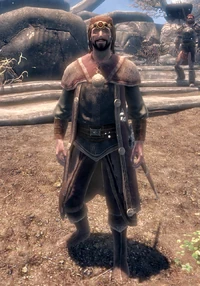
In Skyrim, the High King or Queen typically inherits the throne by birth and rules for life or until abdication.[citation needed] In the event that no direct heir to the throne exists, High Kings are selected by a moot, or vote, conducted by the current Jarls of each of the nine Holds.[1] High Kings are traditionally either related to the previous High King,[2] or a Jarl of one of the Holds.[1] Votes occur most commonly when the previous High King dies. By Nordic tradition, a High King can be challenged in a duel of arms for the right to the throne. If they refuse, the challenger has grounds to call for a moot to elect a new High King.[3][4]
The High King swears fealty to the Emperor, and as such Solitude is the city most directly influenced by Imperial culture and politics; thus the Jarl of Solitude has served as High King for generations. According to some source the Moot is, therefore, more formality and theater than anything else.[1] Other sources state that the Moot always meets to select a new High King.[5] Originally, the High King was based in Windhelm, as it was the first capital city established by Ysgramor in the late Merethic Era. The Capital had also shifted to Winterhold sometime in the First Era, but as of the Fourth Era, the High King reigns from Solitude.
History
Second Era
As a result of the Reman Empire's fall in 2E 431, High King Logrolf was assassinated. When Jarl Svartr claimed his daughter Freydis was illegitimate, a partial moot in Windhelm convened Freydis was High Queen, while a partial moot in Solitude convened Svartr was High king. As a result, the province was split into the West and East kingdoms, ruled separately by each High Kings of the capitals.[6] In 2E 582, High King Svargrim ruled the West Kingdom while High King Jorunn the Skald-King ruled the East Kingdom.[7]
Fourth Era
(right) are the candidates for High King or Queen
of Skyrim during the Skyrim Civil War.
In the Fourth Era, upon the death of High King Torygg, the Jarls could not agree on the next High King. Torygg's widow, Elisif the Fair, the Jarl of Solitude, had a legitimate claim to the throne.[4] However, according to Ulfric Stormcloak, the Jarl of Windhelm, ancient Nord tradition dictates that when the High King is bested in battle, the winner can call a Moot to have a new High King chosen.[4] Ulfric believed this gave him a stronger claim to the throne.[4] This resulted in Civil War because the Empire considered the duel unfair and an act of murder, due to Ulfric's use of the Thu'um.[3] It is strongly implied that Ulfric initiated the challenge, plotting to intimidate the other Jarls into naming him High King,[8][4] though Ulfric and his supporters maintained it was a lawful challenge to prove Torygg's weakness as a leader and Skyrim's wretched condition.[4][9] However, if the city of Solitude is taken by the Stormcloaks and the war resolved in their favor, Ulfric's earlier statement is proven true; saying he supports the decision of the Moot, whether he is crowned King or not. However, he still asks Elisif to swear fealty to him,[4] and all Jarls who fought against him are replaced.[10]
Previous rulers
Listed below are the previous High Kings and High Queens of Skyrim followed by their respective reigns:
- High King Harald of Windhelm, Founder of the Kingdom of Skyrim (1E 143 – 1E 221)[11][12]
- High King Hjalmer of Windhelm – (1E 221 – 1E 222)
- High King Vrage of Windhelm – (1E 222 – 1E 2?)[2][13]
- High King Gellir – (1E 2? – 1E ?)[14]
- High King Borgas of Winterhold, last of the Ysgramor Dynasty (1E ? – 1E 369)[15]
- High King Olaf One-Eye of Whiterun (1E 420 – 1E 452)[11]
- High King Kjoric the White (1E 4? – 1E 478)[16]
- High King Hoag Merkiller (1E 478 – 1E 480)[16][17]
- High King Wulfharth (1E 480 – 1E 533)[11]
- High King Logrolf of Windhelm (2E ? – 2E 431)[6]
- High Queen Freydis of Windhelm - disputed only controlled Eastern Skyrim – (2E ? – 2E ?)[6][18]
- High King Svartr of Solitude - disputed only controlled Western Skyrim – (2E ? – 2E ?)[6]
- High Queen Mabjaarn Flame-Hair of Windhelm - disputed only controlled Eastern Skyrim – (2E ? – 2E 583)[7]
- High King Svargrim of Solitude - disputed only controlled Western Skyrim (2E 561 – 2E ?)
- High King Jorunn the Skald-King of Windhelm and the Ebonheart Pact - disputed only controlled Eastern Skyrim – (2E 582 – 2E ?)[7]
- High King Erling of Solitude (the era he reigned in is unknown)[19]
- High King Istlod of Solitude, the father of Torygg (4E ? – 4E ?)[3]
- High King Torygg of Solitude (4E ? – 4E 201) [20]
The Jagged Crown
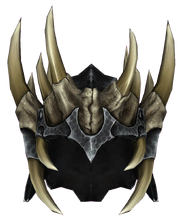
The Jagged Crown, the Crown Jewel of the High King of Skyrim.
- Main article: The Jagged Crown
The Jagged Crown is the crown of the High King of Skyrim and was used to symbolizes the power over Skyrim. It is made from the teeth and bones of dragons. It is believed to date back to the time of King Harald and is said to contain a portion of the power of every king or queen who wore it since.[21]
The last monarch to wear the crown was King Borgas, but it was believed lost when he was killed in the Wild Hunt of 1E 369. Legend holds that his body was secretly returned to Skyrim and buried with the crown, but the exact whereabouts were lost in the following War of Succession.[21] During the Civil War questline, the Dragonborn can help recover the crown for either the Imperial Legion or the Stormcloaks, providing a great symbolic victory to the side in question.
The Crown of Verity
- Main article: Crown of Verity
The Crown of Verity was an alternative to the Jagged Crown created when the Jagged Crown was lost in the Wild Hunt of 1E 369. It infamously rejected Asurn Ice-Breaker as High King in the fifth century of the First Era, cementing its authority deep into Skyrim's politics.[6]
High Rock
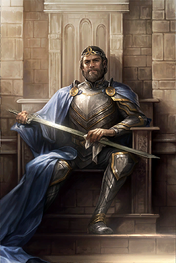
High King Emeric
- Main article: Emeric of Cumberland
In High Rock there has only ever been one High King, Emeric of Cumberland. A master warrior, brilliant politician, well-rounded in trading, speechcraft, and a brilliant strategist, he was also the King of Wayrest, High King of High Rock, the founder and Leader of the Daggerfall Covenant, and the founder of the Cumberland Dynasty.
Hammerfell
- High King Thassad II, the last Na-Totambu High King of Hammerfell.[22]
- Prince A'Tor, Thassad II Son and heir, mortally wounded during the Battle of Hunding Bay.[23]
Other nobility
Trivia
- In ancient and Early Medieval Ireland, the high king (Ard Ri) was a symbolic ruler who professed to have lordship over the whole of Ireland. However, most high king's actual power rarely extended past their native tuatha (tribal kingdom).
- Similarly, in ancient and medieval Germanic Europe (on which Skyrim and the Nords are largely based), authority was usually bestowed upon a high king or emperor, who held the title but had varying levels of authority, depending on the country (in England and Germany, very little; in Scandinavia a fair amount). This system was developed out of ancient Germanic tribal tradition, where their rulers were elected by the freemen of the tribe (and in turn, higher rulers were elected from these representatives of the tribes).
Appearances
- The Elder Scrolls Adventures: Redguard
- The Elder Scrolls IV: Oblivion (mentioned only)
- The Elder Scrolls V: Skyrim
- The Elder Scrolls Online
References
- ↑ 1.0 1.1 1.2 Skyrim's Rule
- ↑ 2.0 2.1 Pocket Guide to the Empire, First Edition: Skyrim
- ↑ 3.0 3.1 3.2 Dialogue with Sybille Stentor
- ↑ 4.0 4.1 4.2 4.3 4.4 4.5 4.6 Dialogue with Ulfric Stormcloak
- ↑ Loading Screens (Skyrim)
- ↑ 6.0 6.1 6.2 6.3 6.4 The Crown of Freydis
- ↑ 7.0 7.1 7.2 Events of The Elder Scrolls Online
- ↑ Dialogue with Elisif the Fair
- ↑ Dialogue with Gerdur
- ↑ Conclusions of hold battles in the Skyrim Civil War
- ↑ 11.0 11.1 11.2 Plaque outside of the Palace of the Kings
- ↑ Frontier, Conquest
- ↑ King Edward, Book X
- ↑ The Aetherium Wars
- ↑ A History of Daggerfall
- ↑ 16.0 16.1 Rislav the Righteous
- ↑ The Five Songs of Wulfharth
- ↑ Dialogue with Oengul War-Anvil
- ↑ Walking the World, Vol XI
- ↑ Nords Arise!
- ↑ 21.0 21.1 Dialogue with Galmar Stone-Fist
- ↑ Pocket Guide to the Empire, First Edition: Hammerfell
- ↑ Intro of The Elder Scrolls Adventures: Redguard

